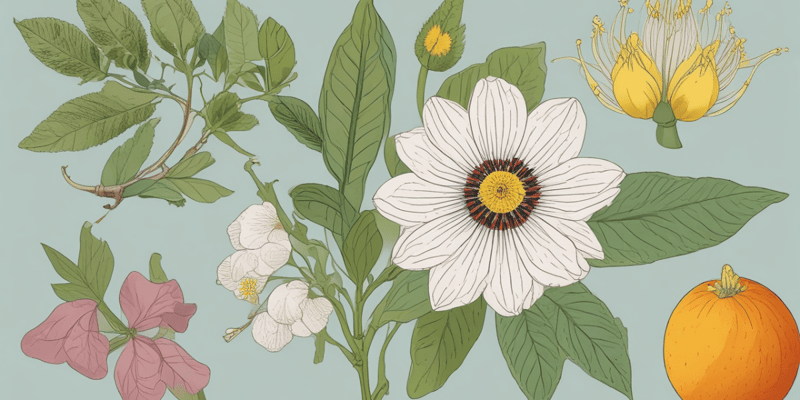Podcast Beta
Questions and Answers
Which type of fruit develops from nothing but the ovary wall?
Which fruit type often has the receptacle as an accessory tissue?
Which term describes a mature fruit that is fleshy and juicy?
Which type of fruit opens to release seeds?
Signup and view all the answers
What is the fruit called that develops from several unfused carpels that fuse together?
Signup and view all the answers
From which plant part does an accessory fruit mainly develop?
Signup and view all the answers
What is the term used to describe the reproductive structure formed from the ovary as a result of fertilization of the ovule(s)?
Signup and view all the answers
Which layer of the fruit is the innermost one that surrounds the seed?
Signup and view all the answers
What is the term for a fruit that develops from an inflorescence, where several fruits merge and fuse into a single fruit body?
Signup and view all the answers
Which type of fruit develops from one flower with one carpel or fused carpels?
Signup and view all the answers
What are the three distinct layers of a fruit called collectively?
Signup and view all the answers
Which layer of the fruit is typically fleshy or fibrous and dry?
Signup and view all the answers
What is the origin of the pericarp in a fruit?
Signup and view all the answers
What is the difference between simple and aggregate fruits?
Signup and view all the answers
What is the process of seed development into a fruit called?
Signup and view all the answers
What are the different layers of a fruit called?
Signup and view all the answers
What are the two main types of fruits based on floral origin?
Signup and view all the answers
What is the function of the gynoecium in a flower?
Signup and view all the answers
Study Notes
Fruit Types
- Fruits can be categorized in four ways: floral origin, tissue origin, succulence, and dehiscence
- Aggregate fruit: develops from one flower with several unfused carpels, each carpel becoming a 'fruitlet', which fuse together (partially or mostly), e.g. sweetsop, soursop, raspberry
- Simple fruit: develops from one flower with one carpel or fused carpels, e.g. mango, apple, tomato
- Multiple fruit: develops from inflorescence, several fruits merge and fuse into a single fruit body, e.g. pineapple, noni, breadfruit
Tissue Origin
- True fruit: develops from nothing but ovary wall, most fruits, e.g. temperate apple, temperate pear
- Accessory fruit: develops from other parts of flower as well as ovary wall, e.g. cashew apple, strawberry
Succulence and Dehiscence
- Fruits may be fleshy/succulent (juicy) or dry (stony, papery, woody, etc.)
- Fruits may be dehiscent (open to release seeds) or indehiscent (remain closed, seeds retained and dispersed within fruit)
Fruit Structure
- Fruit consists of three layers: outermost epicarp (exocarp), middle layer mesocarp, and inner layer endocarp
- Pericarp: the three layers collectively
- Fruit has two 'scars': scar of attachment to receptacle and scar from dried/withered style
Inflorescence
- Inflorescence: cluster of flowers in a particular arrangement
- Examples of inflorescence: umbel, capitulum/head, spike/raceme
Flowers
- Flower diversity: modifications/variations of structure
- Modifications related to methods of pollination and/or seed dispersal
- Examples of flower diversity: number of whorls, number of parts per whorl, fusion of parts, planes of symmetry
Studying That Suits You
Use AI to generate personalized quizzes and flashcards to suit your learning preferences.
Related Documents
Description
Test your knowledge on botanical terms related to inflorescences and fruits with this quiz. Learn about different types of flower clusters and reproductive structures formed from ovaries. Identify arrangements like umbels, capitulums, spikes, and racemes.




